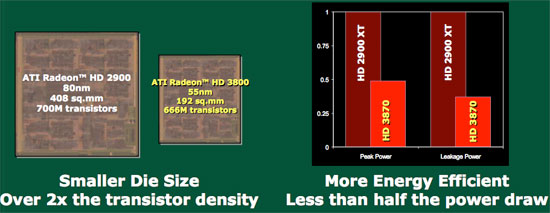ATI Radeon HD 3870 & 3850: A Return to Competition
by Anand Lal Shimpi & Derek Wilson on November 15, 2007 12:00 AM EST- Posted in
- GPUs
Finally. We're finally getting somewhere interesting in the graphics industry. Although they're sure to return, the days of reviewing $600 graphics card after $600 graphics card are on hiatus, and instead we're reviewing a new class of mainstream cards with earth-shattering performance.
NVIDIA's GeForce 8800 GT kicked off the trend, in one fell swoop making almost all of NVIDIA's product line obsolete thanks to the high performance and low price tag (we'll talk about that last part shortly). But what we saw there wasn't a fluke, it was a preemptive strike against AMD, who have been hard at work on an affordable GPU of their own.
This new product, like the 8800 GT, would be aimed squarely at the $150 - $250 market segment, something both AMD and NVIDIA did a horrible job at with mainstream releases earlier this year (2600 and 8600 both sucked guys).
Introducing the RV670
AMD's two new graphics cards launching today are both based off a new GPU, referred to internally as the RV670. The basic architecture of the hardware is largely unchanged from R600; there has been some additional functionality added, and a great deal of internal bandwidth removed, but other than that this is very much an R600 based part.

The biggest news of this part is that it is fabbed on a 55nm TSMC process. This is a half-node process based on 65nm technology, giving AMD an advantage in die size (cost) and potentially clock speed and/or power.

Historically, AMD's RV series has been a cost cut version of their R series designed for lower end volume parts, and that's where RV670 started. Right of the bat, half the external and internal memory bandwidth of R600 was cut out. External bandwidth dropped from 512-bit to 256-bit, but AMD stuck with 8 memory channels (each dropped from 64bit to 32bit).
Internally, the ring bus dropped from 1024-bit to 512-bit. This cut in bandwidth contributed to a significant drop in transistor count from R600's ~720M. RV670 is made up of 666M transistors, and this includes the addition of UVD hardware, some power saving features, the necessary additions for DX 10.1 and the normal performance tuning we would expect from another iteration of the architecture.

Processing power remains unchanged from the R600; the RV670 features 320 stream processors, 16 texture units and 16 redner back-ends. Clock speeds have gone up slightly and memory speeds have increased tremendously to make up for the narrower memory bus.
The RV670 GPU is also fully PCI Express 2.0 compliant like NVIDIA's G92, the heart and soul of the GeForce 8800 GT.










117 Comments
View All Comments
Parhel - Thursday, November 15, 2007 - link
Even though you're wrong, do you mind if I use your math on my upcoming trip to Europe? It would really help me out. :)MrKaz - Thursday, November 15, 2007 - link
Since no one seems to ask but since when crossfire works on Nvidia 680i?Also you said this correctly over load power:
"The difference is negligible, but when you include the fact that the 8800 GT is faster, the Radeon HD 3870 actually has worse performance-per-watt than the competition. "
But you unfortunately failed to mention this over idle power:
"The difference is huge, especially when comparing to the older ATI and NVIDIA offers, even when comparing to the new 8800GT it’s still a 40 Watts difference."
Anand Lal Shimpi - Thursday, November 15, 2007 - link
It doesn't, we used a P965 board for CrossFire, but you couldn't have known that - thus I've updated the test table :)And I've included commentary on the idle power of the 3800 series, my apologies for the oversight.
Take care,
Anand
MrKaz - Thursday, November 15, 2007 - link
Anand do you think Crossfire scaling would improve if you used some X38 or rd580?Or the 4x PCIe slot on 965 doesn’t affect it much?
Does the 790 and Phenom get reviewed this month?
Continue the good work!
Anand Lal Shimpi - Thursday, November 15, 2007 - link
Personally I don't think the chipset is at fault for poor scaling here, but you do make a good point - I'll see if we can run some numbers internally and figure that out.Indeed this isn't the only AMD product that gets reviewed this month...
:)
Anand Lal Shimpi - Thursday, November 15, 2007 - link
Woops, my mistake, Derek ran the CF tests and they were on a P35 board and not a P965. I've updated the article accordingly.Take care,
Anand
MrKaz - Thursday, November 15, 2007 - link
Thanks Anand!jcromano - Thursday, November 15, 2007 - link
From page 5:I have been unable to use the RTPE for the past two weeks or so. What's the trick? Here is the error it gives me:
Jim
Crassus - Thursday, November 15, 2007 - link
Yep. Same here error message here, both in Firefox and IE. I've been trying to make use of the RTPE for weeks now, without success. Or was it converted to Anandtech "staff only" use? ;c)jcromano - Thursday, November 15, 2007 - link
Ok. Thanks for the quick response. I look forward to the return of the RTPE, but maybe your shopping page can substitute in the meantime.Cheers,
Jim